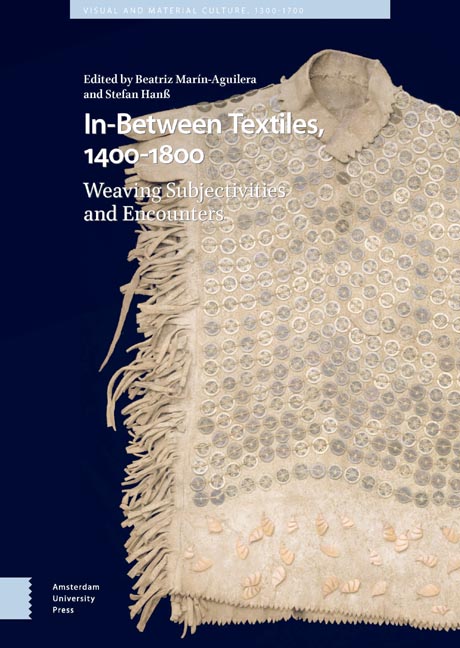Book contents
- Frontmatter
- Dedication
- Miscellaneous Frontmatter
- Table of Contents
- List of Illustrations
- Acknowledgements
- 1 Subjectivities In-Between Early Modern Global Textiles
- Part I Unhomeliness, Mimicry, and Mockery
- Part II The Material Enunciation of Difference
- Part III Identity Effects In-Between the Local and the Global
- Part IV Material Translation and Cultural Appropriation
- Archives, Libraries, and Museums (Abbreviations)
- Select Bibliography
- Index
15 - Globalisation and the Manufacture of Tablet-Woven Sanctuary Curtains in Ethiopia in the Eighteenth Century
Published online by Cambridge University Press: 14 October 2023
- Frontmatter
- Dedication
- Miscellaneous Frontmatter
- Table of Contents
- List of Illustrations
- Acknowledgements
- 1 Subjectivities In-Between Early Modern Global Textiles
- Part I Unhomeliness, Mimicry, and Mockery
- Part II The Material Enunciation of Difference
- Part III Identity Effects In-Between the Local and the Global
- Part IV Material Translation and Cultural Appropriation
- Archives, Libraries, and Museums (Abbreviations)
- Select Bibliography
- Index
Summary
Abstract
This chapter examines tablet-woven sanctuary curtains in eighteenth-century Ethiopia, arguing that the translation of Indian silk relied on the mobility of textile matter and textile experts. In this case, presumably Egyptian weavers processed Indian silk under royal patronage in Ethiopia. The chapter also includes a weave remaking experiment that reveals the astonishing degree of innovation and creativity resulting from such transculturally translated textiles.
Keywords: tablet-weaving; Ethiopia; Indian silk; material translation; remaking
Context and Historical Background
Five tablet-woven hangings from Ethiopia are an obvious example of global trade, exchange, and knowledge transfer in the eighteenth century. They are made of silk apparently of Indian origin and were woven in Ethiopia under royal patronage by what were most likely to have been a weaver or weavers from Egypt. Consisting of panels measuring approximately 70 centimetres in width and just over 5 metres in length, they also represent the largest tablet-woven textiles ever known to have been produced anywhere on the face of the globe at any time in human history. Three of the five are today located in Western museums: two, each consisting of a single panel, are in the British Museum (BM) (Fig. 15.1) and another, made of three panels, is in the Royal Ontario Museum, Toronto (ROM) (Fig. 15.2). Two other triple-panelled examples are preserved in the ancient monastery of Abba Gärima, in Tǝgray Province, Ethiopia (Figs. 15.3–4). Their origins are entirely undocumented, although the iconography apparent on the BM and ROM pieces associates them with the reigns of the Gondärine Kings Bäkaffa (r.1721–1730) and his son Iyasu II (r.1730–1755). Since the time they were acquired during the British punitive expedition to Ethiopia in 1868, they have frequently been referred to as “Gondär” hangings and are thought to have hung in royal foundations in that capital town. The patronage of the hangings from Abba Gärima is attributed to Ras Mika’el “Sǝḥul,” governor of Tǝgray Province from 1759 to his death in 1777 and, from 1768, the son-in-law of Mǝntǝwwab, the consort of King Bäkaffa. The monks of Abba Gärima claim that their hangings were made by a foreign people known as Seglin or Sehlin working in the village of May Zbi south of Adwa.
- Type
- Chapter
- Information
- In-Between Textiles, 1400-1800Weaving Subjectivities and Encounters, pp. 327 - 346Publisher: Amsterdam University PressPrint publication year: 2023



